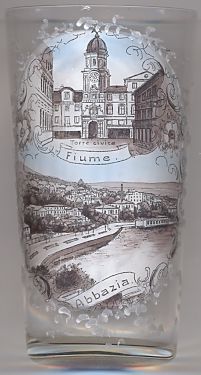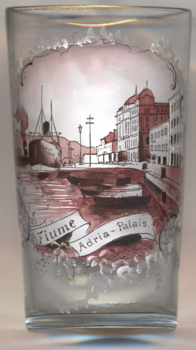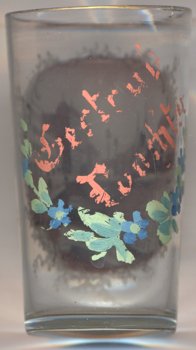

|
| HRVATSKA | CROATIA |
| županija: Primorsko-goranska |
 Rijeka is located on Kvarner Bay, an inlet of the Adriatic Sea. With a population of about 144,000 (2001)
it is Croatia's third-largest city. Rijeka is the country's principal seaport and is the administrative seat of the
Primorsko-goranska županija (Primorje-Gorski Kotar county) that includes the Kvarner Bay and the surrounding
Northern Croatian seacoast, and the mountainous region of Gorski Kotar.
Rijeka is located on Kvarner Bay, an inlet of the Adriatic Sea. With a population of about 144,000 (2001)
it is Croatia's third-largest city. Rijeka is the country's principal seaport and is the administrative seat of the
Primorsko-goranska županija (Primorje-Gorski Kotar county) that includes the Kvarner Bay and the surrounding
Northern Croatian seacoast, and the mountainous region of Gorski Kotar.
Though traces of Neolithic settlements can be found in the region, the earliest settlements on the site were Celtic Tarsatica (modern Trsat, now part of Rijeka) on a hill and the tribe of mariners, the Liburni in the natural harbor below. The municipium founded by the Romans was named Flumen (Latin for 'river'), which became the origin of the city's name in Croatian (Rijeka, or Reka in Ekavian dialects) and Italian (Fiume), which both also simply mean 'river'. After the 4th century the city was rededicated as Flumen Sancti Viti, the city's patron saint. This name survived in the Hungarian name, Szentvid, and the German version used until the 19th century, Sankt Veit am Flaum. From the 5th century onwards, the town came under successive Frankish, Croatian and Magyar rule before coming under the control of the Austrian Habsburgs in 1466. Created a free port in 1723, Fiume was passed during the 18th and 19th centuries among the Habsburgs' Austrian, Croatian, and Hungarian possessions until its attachment to the latter kingdom for the third and last time in 1870. Although Croatia had a constitutional autonomy within Hungary, the city of Fiume was independent, governed directly from Budapest by an appointed governor, as Hungary's only international port. There was competition between Austria's port of Trieste and Hungary's Port of Rijeka (Fiume).
Habsburg-ruled Austria-Hungary's defeat and disintegration in the closing weeks of World War I led to the establishment of rival Italian and Croatian administrations in the city as both Italy and the founders of the new Kingdom of the Serbs, Croats and Slovenes (later Yugoslavia) claimed sovereignty based on their ethnic populations. After a brief Italian occupation, an international force of French, British and United States troops occupied the city in November 1918 while its future was discussed at the Paris Peace Conference during the course of 1919. Negotiations were interrupted by the city's seizure on September 12, 1919 by a force of Italian nationalist irregulars led by the writer Gabriele d'Annunzio, who eventually established a state the Italian Regency of Carnaro. On November 12, Italy and Yugoslavia concluded the Treaty of Rapallo, under which Fiume/Rijeka was to be an independent state, the Free State of Fiume/Rijeka, under a regime acceptable to both. A period of diplomatic acrimony closed with the Treaty of Rome (January 27, 1924), which assigned Fiume to Italy and Sušak (today part of Rijeka) to Yugoslavia, with joint port administration. Formal Italian annexation (March 16, 1924) inaugurated twenty years of Fascist rule and a policy of forced Italianization of the Croatian population, followed by twenty months of German military occupation during World War II. The German occupation was ended by Yugoslav troops which advanced as far west as Trieste. Fiume finally became the Croatian (and until June 1991, Yugoslav) city of Rijeka, a situation formalised by the Paris peace treaty (1947) between Italy and the wartime allies. Once the change in sovereignty was formalised, most of the Italian-speaking part of the population fled Tito's communist regime and went into exile. Today, the city's economy largely depends on sea transport, shipbuilding and tourism. Rijeka was chosen as a European Capital of Culture for 2020 (together with Galway, Ireland; see list of other European Capitals of Culture depicted on glasses of this collection).
 The Baroque
The Baroque  city tower (gradski toranj; Italian: torre civica)
[left, no. 2145: top picture]
stands atop the arched gateway which links the Korzo to the inner city
and already had been part of the medieval fortifications. A clock had already been installed in the 17th century.
In 1750, Rijeka was struck by a disastrous earthquake. Maria Theresia of Austria and Queen of Hungary allocated funds for the town's reconstruction and she
also approved the general urban plan for a new town (civitas nova), but under the condition that the Old Town would remain
untouched. A new set of four clocks was installed in 1784. These clocks were operational until 1873, after which date they were replaced by
clockwork that had been exhibited in Vienna during an international exhibition. The clock is
still running today. In 1890, architect Filbert Bazarig added a touch of Historicism to the tower and covered it with
its characteristic dome.
city tower (gradski toranj; Italian: torre civica)
[left, no. 2145: top picture]
stands atop the arched gateway which links the Korzo to the inner city
and already had been part of the medieval fortifications. A clock had already been installed in the 17th century.
In 1750, Rijeka was struck by a disastrous earthquake. Maria Theresia of Austria and Queen of Hungary allocated funds for the town's reconstruction and she
also approved the general urban plan for a new town (civitas nova), but under the condition that the Old Town would remain
untouched. A new set of four clocks was installed in 1784. These clocks were operational until 1873, after which date they were replaced by
clockwork that had been exhibited in Vienna during an international exhibition. The clock is
still running today. In 1890, architect Filbert Bazarig added a touch of Historicism to the tower and covered it with
its characteristic dome.
The bottom picture on glass no. 2145 shows a view of the nearby spa town Opatija (here labeled in Italian: Abbazia).

 The
The  Adria-Palais or Palazzo Adria [near left, no. 3688: right]
was built in 1897 for the Hungarian maritime shipping company "Adria". The monumental façade dominates the entire
port of Rijeka (then Fiume). It was designed by the architect Francesco Mattiassi and built by architect Giacomo Zammattio.
The façade is ornated by numerous sculptures made by Sebastiano Bonomi. After World War II the building was
renamed "Jadran" and is now the seat of Jadrolinija, the most important Shipping company of Croatia.
Adria-Palais or Palazzo Adria [near left, no. 3688: right]
was built in 1897 for the Hungarian maritime shipping company "Adria". The monumental façade dominates the entire
port of Rijeka (then Fiume). It was designed by the architect Francesco Mattiassi and built by architect Giacomo Zammattio.
The façade is ornated by numerous sculptures made by Sebastiano Bonomi. After World War II the building was
renamed "Jadran" and is now the seat of Jadrolinija, the most important Shipping company of Croatia.
[http://en.wikipedia.org/wiki/Rijeka, http://www.rijeka.hr/;
https://it.wikipedia.org/wiki/Palazzo_Adria, https://it.m.wikipedia.org/wiki/Jadrolinija]
![[scale]](lineal.jpg)